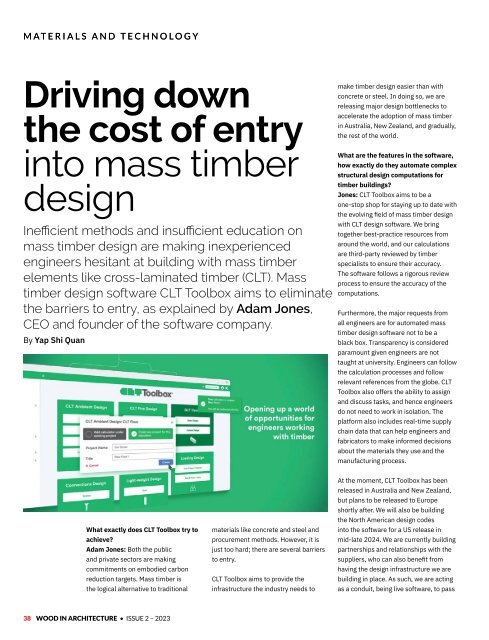WIA_ISSUE2_2023
Create successful ePaper yourself
Turn your PDF publications into a flip-book with our unique Google optimized e-Paper software.
MATERIALS AND TECHNOLOGY<br />
Driving down<br />
the cost of entry<br />
into mass timber<br />
design<br />
Inefficient methods and insufficient education on<br />
mass timber design are making inexperienced<br />
engineers hesitant at building with mass timber<br />
elements like cross-laminated timber (CLT). Mass<br />
timber design software CLT Toolbox aims to eliminate<br />
the barriers to entry, as explained by Adam Jones,<br />
CEO and founder of the software company.<br />
By Yap Shi Quan<br />
1<br />
make timber design easier than with<br />
concrete or steel. In doing so, we are<br />
releasing major design bottlenecks to<br />
accelerate the adoption of mass timber<br />
in Australia, New Zealand, and gradually,<br />
the rest of the world.<br />
What are the features in the software,<br />
how exactly do they automate complex<br />
structural design computations for<br />
timber buildings?<br />
Jones: CLT Toolbox aims to be a<br />
one-stop shop for staying up to date with<br />
the evolving field of mass timber design<br />
with CLT design software. We bring<br />
together best-practice resources from<br />
around the world, and our calculations<br />
are third-party reviewed by timber<br />
specialists to ensure their accuracy.<br />
The software follows a rigorous review<br />
process to ensure the accuracy of the<br />
computations.<br />
Furthermore, the major requests from<br />
all engineers are for automated mass<br />
timber design software not to be a<br />
black box. Transparency is considered<br />
paramount given engineers are not<br />
taught at university. Engineers can follow<br />
the calculation processes and follow<br />
relevant references from the globe. CLT<br />
Toolbox also offers the ability to assign<br />
and discuss tasks, and hence engineers<br />
do not need to work in isolation. The<br />
platform also includes real-time supply<br />
chain data that can help engineers and<br />
fabricators to make informed decisions<br />
about the materials they use and the<br />
manufacturing process.<br />
What exactly does CLT Toolbox try to<br />
achieve?<br />
Adam Jones: Both the public<br />
and private sectors are making<br />
commitments on embodied carbon<br />
reduction targets. Mass timber is<br />
the logical alternative to traditional<br />
materials like concrete and steel and<br />
procurement methods. However, it is<br />
just too hard; there are several barriers<br />
to entry.<br />
CLT Toolbox aims to provide the<br />
infrastructure the industry needs to<br />
At the moment, CLT Toolbox has been<br />
released in Australia and New Zealand,<br />
but plans to be released to Europe<br />
shortly after. We will also be building<br />
the North American design codes<br />
into the software for a US release in<br />
mid-late 2024. We are currently building<br />
partnerships and relationships with the<br />
suppliers, who can also benefit from<br />
having the design infrastructure we are<br />
building in place. As such, we are acting<br />
as a conduit, being live software, to pass<br />
38 WOOD IN ARCHITECTURE • ISSUE 2 – <strong>2023</strong>

















